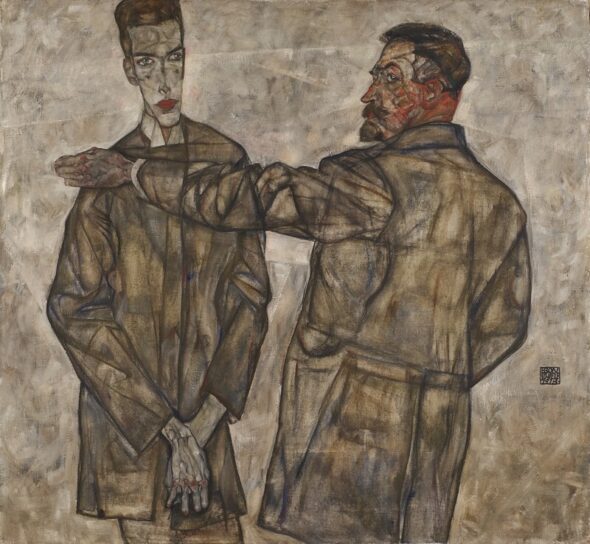Egon Schiele, Double Portrait of Heinrich and Otto Benesch, 1913

Oil on canvas, 121 x 130 cm
Collection Lentos Art Museum Linz, Inv. Nr. 12
The 1913 “Doppelbildnis Heinrich und Otto Benesch [Double Portrait of Heinrich and Otto Benesch]”, one of the chief works of Expressionism in Austria, is Schiele’s psychologising study of two men he knew well, Heinrich Benesch, a paternal friend from 1908 onward, a loyal Schiele collector and Chief Inspector of the k. and k. Railways, and his son Otto Benesch, then 17, who was to become an art historian and a long serving director of the Albertina, where he was in charge, among other things, of putting together the museum’s Schiele collection.
That the Beneschs were enthusiastic supporters of Schiele’s art, which was considered highly controversial at the time, is plainly in evidence in several letters. The elder Benesch, for example, who frequently tided Schiele over with small amounts of money and who was the only one to visit Schiele when the latter was in prison for a few days in 1910 wrote:
“… there is one thing, lieber Herr Schiele, I would urge you to abstain from: do not throw any of your sketches, whatever they may represent, even the most unassuming trifles, into the fireplace. Please write the following equation on your fireplace: ‘Ofen=Benesch’ [fireplace=Benesch]…”
On 18 March 1913, shortly before the double portrait finally took shape, Benesch wrote to Schiele:
“… You have twice promised to draw me but to date you have not honoured that promise. You have performed that labour of love for all friends of your art bar me. What have I done to deserve thus being singled out? Am I not worthy of your attention? What motivates me in this matter is the wish to have a visible token of your sympathy, not the wish to have a portrait of myself. That I need to remind you of your promise of course means that you have spoilt in advance part of the pleasure the portrait would give me. It is indeed bitter to be treated by a friend as a quantité negligeable…”
In the final version of the portrait, father and son confront one another in isolation with averted gaze. In the foreground, the apparently dominant father, seen from behind, seems to consign his son to the background with his extended left arm. As is evident from several sketches, Schiele introduced changes to his original plan as he went about to realise it – Heinrich Benesch’s left arm hanging limply from the shoulder is still clearly visible.
This formal intervention brought about a fundamental reshuffle of the entire pictorial composition: the extended arm, assuming the function of a barricade, enhances the tension between father and son while at the same time serving as the only link connecting the two figures. Heinrich Benesch is depicted as an energetic, hands-on person, willing to ward off the observer’s visual intrusion from his shy, reclusive son. The subjects’ forced facial expression and their body language – the father’s hectic movement and the ostensibly introverted son with his clenched hands – hint at a generation gap. Overstretching proportions and exaggerating colours both serve to unmask the subjects. Physical deformation makes states of the psyche – suffering, depression, arousal – visible.
The image composition is clear. It is tectonically structured and dominated by predominantly vertical axes. An extremely economical colour scheme corresponds to the austere drawing. Alongside dominant tones of green, beige, and grey, loud orange-red highlights provide expressive contrasts. The transparent paint application and the angular, jagged lines are reminiscent of the Cubist formal vocabulary.
Dispensing with spatial depth and all decorative details, the painting stuns with its austerity and asceticism. The artist’s psychological approach and the expressive means he deploys bring the subjects’ mental condition and their inner life to the fore.
Schiele the artist is here seen following in the footsteps of Sigmund Freud, whose psychoanalysis, which was taking shape at that time in Vienna, revolutionised our views about the workings of the psyche.
